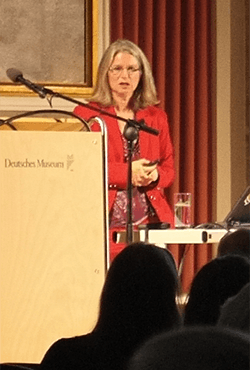Monika Ritsch-Marte
| Monika Ritsch-Marte | |
|---|---|
|
Monika Ritsch-Marte at Deutsches Museum | |
| Born |
September 26, 1961 Höchst, Austria |
| Nationality | Austrian |
| Fields | Physics |
| Institutions |
Division of Biomedical Physics Medical University of Innsbruck |
| Alma mater |
University of Innsbruck University of Waikato |
| Doctoral advisor |
Daniel Frank Walls Crispin Gardiner |
Monika Ritsch-Marte (born September 26, 1961 in Höchst) is an Austrian physicist in the fields of biomedical optics, theoretical quantum optics and non-linear optics.
Life and education
Monika Ritsch-Marte was raised in the Austrian province of Vorarlberg, graduated in 1980 from grammar school in Bregenz, and earned a physics diploma from the University of Innsbruck in 1984. In 1985 she went to the University of Waikato in Hamilton, New Zealand, earning her Ph.D. in 1988 under the supervision of Daniel Frank Walls and Crispin Gardiner with a thesis on generation and application of non-classical states of light, so-called squeezed states of light. She returned to Innsbruck for postdoctoral research in the group of Peter Zoller and then stayed at the University of Innsbruck for several years on a "Charlotte-Bühler Habilitationsprogramm" of the Austrian Science Fund. Some extended research visits abroad (Helsinki, JILA/Boulder, Konstanz) fall into this period, as well as half a year at the Universita degli Studi di Milano in the group of Luigi Lugiato supported by an APART grant from the Austrian Academy of Sciences. In 1995 Monika received her Habilitation in the field of Theoretical Physics as the University of Innsbruck. In 1998 she was appointed full professor in medical physics at the medical faculty of the University of Innsbruck, which meant a re-orientation towards biomedical optics (from this time on publishing under the name Ritsch-Marte). With the creation of the Medical University of Innsbruck as an independent university in 2004 she was appointed director of the Division of Biomedical Physics.
In 2007 she was elected the first female president of the Austrian Physical Society.[1] For her achievements in the fields of optics and photonics in 2013 Monika Ritsch-Marte was elected OSA-Fellowship by the Optical Society of America. In 2014 she was elected as a corresponding member of the Austrian Academy of Sciences and in 2016 raised to full membership.
Monika Ritsch-Marte is married to physicist Helmut Ritsch with whom she has two daughters.
Work
Since moving into applied optics Ritsch-Marte has contributed to the development and application of microscopic methods and optical tweezers. Her research group has pioneered new usages for spatial light modulators (SLM) in the form of liquid-crystal displays to optical microscopy. As a programmable Fourier filters SLMs allow rapid switching between different microscopy modalities (bright field, dark field, phase contrast) without the need for changing any hardware components.
In the scope of the ERC Advanced Investigator Grant catchIT (= Coherently Advanced Tissue and Cell Holographic Imaging and Trapping) her group also developed methods of optical manipulation of ever larger particles, e.g. the optical "macro-tweezers" system, a large volume dual-beam mirror trap. This dual-beam approach is suitable to trap and guide swimming micro-organisms such as Euglena without inducing any optical damage. For even larger particles a combination of optical tweezers and an ultrasonic trap was developed.
Another field of research in Monika Ritsch-Marte's group is non-linear microscopy, e.g. chemically-selective coherent anti-Stokes Raman scattering (CARS), in particular they have developed a non-scanning (wide-fied) CARS variant.
Monika Ritsch-Marte and her colleague Stefan Bernet hold several patents (e.g. spiral-phase contrast microscopy or a diffractive Moiré lense with tunable refraction index).[2]
Monika Ritsch-Marte is also committed to the promotion of women in physics. Together with Claudia Draxl she chaired a working group of the Austrian Academy of Sciences which was dedicated to the promotion of women in physics. During her presidency of the Austrian Physical Society Monika Ritsch-Marte initiated the Lise-Meitner-Lectures,[3] an event series organised yearly in cooperation with the German Physical Society consisting of public lectures by distinguished female physicists.
Awards
- 2016 Full Member of the Austrian Academy of Sciences[4]
- 2013 OSA Fellow of the Optical Society of America[5]
- 2011 Science award of the province of Tyrol[6]
- 2011 Grand Prix for the patent of a tunable Moiré lense at the South Corean Women's Invention Exposition KIWIE[7]
- 2010 "ERC Advanced Grant" of the European Research Council (endowed with Euro 2.5 million) for her research project catchIT[8][9]
- 2009 Kardinal Innitzer Prize for natural sciences Naturwissenschaften of the Archdiocese of Vienna[10]
- 2008 SUPA Distinguished Visitor Award of the Scottish universities
- 2008 Science award of the province of Vorarlberg
- 1993 Ludwig Boltzmann Prize of the Austrian Physical Society (shared with H. Ritsch)
- 1992 Research award of the city of Innsbruck
- 1988 Ph.D. award, University of Waikato, New Zealand
References
- ↑ History of the Austrian Physical Society
- ↑ results of the Google patent search
- ↑ Lise Meitner Lectures 2008
- ↑
- ↑ Monika Ritsch-Marte at the OSA website
- ↑ Tiroler Landespreis für Wissenschaft 2011
- ↑ Österreichische Wissenschaftlerinnen bei internationaler "Erfinderinnen-Messe" erfolgreich
- ↑ List of European Research Council grants awarded to Austrian institutions
- ↑ ERC Advanced Grants 2009 - Updated results (May 2010)
- ↑ Kardinal Innitzer Studienfonds Naturwissenschaftlicher Würdingungspreis geht an die Medizinische Universität Innsbruck
External links
- Biography on the website MRM Innsbruck Medical University
- Division of Biomedical Physics Innsbruck Medical University
